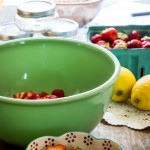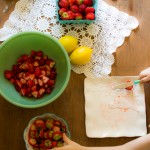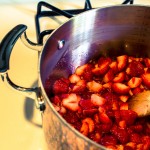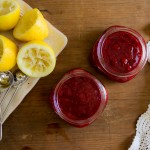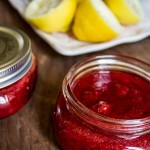 Strawberries are red, berry-like fruits that are well-known for their sweet flavor and enticing aroma. They are unusual for their seeds, which grow on the exterior of the fruit rather than on the inside. The strawberries most commonly eaten today are descendants of the wild strawberry, which is believed to be native to North America. The first garden strawberries were bred in Europe in the 18th century, but strawberries were not cultivated in the United States until the 1800s. Wild strawberries still grow widely across North America, and although the tiny berries are very labor intensive to harvest, they are singularly sweet and flavorful. Because strawberries are quite susceptible to pests and diseases, commercially grown strawberries are some of the most heavily sprayed crops. Furthermore, many commercial strawberry varieties have been bred for size rather than flavor, making home-grown strawberries an especially desirable treat.
Strawberries are red, berry-like fruits that are well-known for their sweet flavor and enticing aroma. They are unusual for their seeds, which grow on the exterior of the fruit rather than on the inside. The strawberries most commonly eaten today are descendants of the wild strawberry, which is believed to be native to North America. The first garden strawberries were bred in Europe in the 18th century, but strawberries were not cultivated in the United States until the 1800s. Wild strawberries still grow widely across North America, and although the tiny berries are very labor intensive to harvest, they are singularly sweet and flavorful. Because strawberries are quite susceptible to pests and diseases, commercially grown strawberries are some of the most heavily sprayed crops. Furthermore, many commercial strawberry varieties have been bred for size rather than flavor, making home-grown strawberries an especially desirable treat.
Growing Tips
The first step toward growing great strawberries is to pick a sunny site with well-drained soil. The fewer weeds there are, the better! Strawberries need quite a bit of fertilizer, so be sure to have plenty of compost on hand. You’ll need to pick a variety of strawberry that is well-suited to New England growing conditions–your best bet is to visit a local nursery and ask for a reliable cultivar. Decide whether you want “June-bearers” or “ever-bearers.” As you may have guessed, the former produces fruit only early in the summer, while the latter continues to produce throughout the summer (though not as vigorously). Plant the dormant roots as soon as soil can be worked in the spring with the woody stem-like part (the “crown”) up toward the surface. Keep young plants well-watered. For June-bearers, pluck off blossoms the first year so plants can get established–your patience will be rewarded the second year. Mulch well with straw. Plants generally produce good yields for about 3 years.
Storage
Strawberries are very fragile and do not store well, so eat as soon as possible. If you must store strawberries, be sure to remove any damaged berries from the container and store (unwashed, with the stems still attached) in the refrigerator for up to a few days. Cut out the leafy, stem-like portion just before serving. For long-term storage, consider freezing berries or making jam.
Nutritional Benefits
Strawberries are very high in Vitamin C, potassium, and folic acid. They also have a compound called “ellagic acid,” which is believed to help combat the formation of certain cancer cells. Strawberries can cause hives in certain individuals or exacerbate existing food allergies, so proceed with caution if you have never eaten them before.
Preparation
Always wash berries just before eating. Fresh strawberries are delicious eaten raw, but they are often prepared in other ways as well. They can be cooked down into jam, added to home-made ice-cream, paired with rhubarb and made into pies, or tossed with sugar and served with shortcakes and cream.
Kate Pace, a volunteer baking, tasting and testing recipes out of the Vermont Fresh Guide tried out this Quick Strawberry Jam recipe. She included information on prep and cook time, as well as extra info in the instructions. You can find Kate on Facebook and Twitter.
Recipe: Quick Strawberry Jam
Serves 4-6 over ice cream or makes 8 PB&J sandwiches
Prep = 15 minutes, Cook 15 minutes
Ingredients:
- 1 quart Strawberries (*if you can’t remember what the sign said at the Farmer’s Market (did you get a ‘pint’ or a ‘quart’) you can measure out 1.5 lbs. or 4 cups quartered) (via Fine Cooking)
- ½ cup Sugar (we used organic cane sugar)
- 2 T lemon juice
Instructions
- Hull Strawberries. There is, of course, a neat little kitchen tool made to hull strawberries but you can also do it with a paring knife. Slice into the berry vertically, aside the stem, and work around until it pops out. Saves so much of the fruit!
- Pulse a few times in a food processor until coarsely chopped. Do not puree the berries! You can chop by hand instead if desired.
- Transfer to a heavy-bottomed saucepan and turn heat to medium-high. Add sugar and lemon juice.
- Cook, stirring frequently, about 10 minutes until the mixture thickens and bubbles. This growing season saw tons of rain and our local strawberries seemed to take longer to thicken. When ten minutes has passed, keep your eye out for the spoon to leave a parting when you draw it through the pan for a second or two.
- Carefully, transfer mixture to a glass jar, allow to cool, and refrigerate. Note: When the jam is prepared this way, it is not shelf-stable, meaning it should be stored in the fridge and consumed within ten days. It can also be frozen.
Recipe: Strawberry Shortcake
serves 6
(adapted from Rombauer et al: The Joy of Cooking)
Ingredients—Shortcakes:
- 1 ¾ cups all-purpose flour
- 1 tablespoon baking powder
- ½ teaspoon salt
- 1 tablespoon sugar
- 5 tablespoons butter, chilled
- ¾ cup milk or half-and-half
Ingredients—Topping:
- 3 pints fresh strawberries, washed, hulled, and sliced
- ¼ cup sugar
- 1 cup heavy cream
Instructions
- Preheat the oven to 450°.
- Mix together the flour, baking powder, salt, and sugar in a large bowl.
- Using a pastry blender or your fingers, cut in the butter to make a coarse meal.
- Add the milk or half-and-half all at once and stir just until the dough begins to come away from the side of the bowl.
- Scrape onto a floured surface. Knead gently a few times to bring the dough together, then roll out to about ½ -inch thick.
- Cut or shape into biscuits and place on an ungreased baking sheet.
- Bake until lightly browned, about 12 minutes. Remove and allow to cool briefly.
- Mix together strawberries and sugar and a medium bowl and allow to sit 5 minutes.
- Beat heavy cream until whipped to desired thickness.
- Split shortcakes, top with berries and cream, and serve.
Note: for a simpler alternative to this recipe, ready-made biscuit dough and whipped cream can be purchased. Frozen strawberries can also be used, but beware—they will be very soft and juicy!
To receive more recipes and tips on your favorite fruits and vegetables, download Vermont Fresh: A Fruit and Vegetable Guide.
We’re looking for more volunteers to test recipes and give us feedback on preparation time, cost and, of course, taste!


